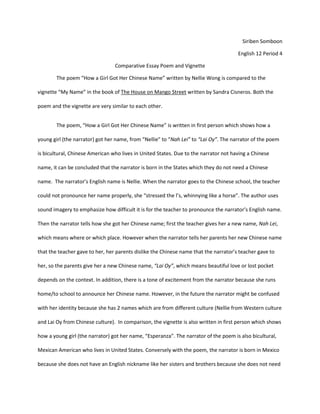
Comparative essay vignette and poem
- 1. Siriben Somboon English 12 Period 4 Comparative Essay Poem and Vignette The poem “How a Girl Got Her Chinese Name” written by Nellie Wong is compared to the vignette “My Name” in the book of The House on Mango Street written by Sandra Cisneros. Both the poem and the vignette are very similar to each other. The poem, “How a Girl Got Her Chinese Name” is written in first person which shows how a young girl (the narrator) got her name, from “Nellie” to “Nah Lei” to “Lai Oy”. The narrator of the poem is bicultural, Chinese American who lives in United States. Due to the narrator not having a Chinese name, it can be concluded that the narrator is born in the States which they do not need a Chinese name. The narrator’s English name is Nellie. When the narrator goes to the Chinese school, the teacher could not pronounce her name properly, she “stressed the l’s, whinnying like a horse”. The author uses sound imagery to emphasize how difficult it is for the teacher to pronounce the narrator’s English name. Then the narrator tells how she got her Chinese name; first the teacher gives her a new name, Nah Lei, which means where or which place. However when the narrator tells her parents her new Chinese name that the teacher gave to her, her parents dislike the Chinese name that the narrator’s teacher gave to her, so the parents give her a new Chinese name, “Lai Oy”, which means beautiful love or lost pocket depends on the context. In addition, there is a tone of excitement from the narrator because she runs home/to school to announce her Chinese name. However, in the future the narrator might be confused with her identity because she has 2 names which are from different culture (Nellie from Western culture and Lai Oy from Chinese culture). In comparison, the vignette is also written in first person which shows how a young girl (the narrator) got her name, “Esperanza”. The narrator of the poem is also bicultural, Mexican American who lives in United States. Conversely with the poem, the narrator is born in Mexico because she does not have an English nickname like her sisters and brothers because she does not need
- 2. an English nickname in Mexico. Both the narrators in the poem and the vignette are bicultural, however Esperanza seems to be more mature because she understands about what is the problem of her name, Nellie doesn’t understand the problem of having 2 names which show two culture identity. The narrator gives the meaning of her names both in English and in Spanish. Her name in English means “hope” which has a positive connotation. On the other hand, in Spanish, her name means “too many letters”, “sadness”, “waiting”, “muddy color” which have negative connotations to show how much the narrator dislike her name. The author also uses synethesia, to show how people in her school, her classmate can’t pronounce her name properly as if her name “were made out of tin and hurt the roof of your [her classmate’s] mouth” which is similar to how the teacher can’t pronounce Nellie’s name in the poem. The narrator uses comparison to compare her grandmother and herself to show the similarities between them having the same name; both of them are born in the year of the horse. Furthermore, the narrator uses flashback explaining what happened to her grandmother who has the same name to show that the narrator doesn’t like her name because the narrator doesn’t want to end up like her grandmother who “looked out the window her whole life, the way so many women sit their sadness on an elbow”. There is also a tone of dissatisfaction with the name narrator is given (Esperanza) because the narrator wants to “baptize herself under a new name, a name more like the real her, the one nobody sees”. This contrasts with the poem because in the poem, Nellie likes her Chinese name because after she got her Chinese name, she “ran” to tell her parents her new name which shows the tone of excitement of the narrator having a new name. Both the poem and the vignette are similar. They also share a similar theme of the importance of the name in society. Name can show the identity of a person, just like the name Esperanza which shows a Mexican culture and Lai Oy which shows a Chinese culture. The name is very important in the society because Esperanza wants to change her name to a name that is more like the real her and Nellie’s Chinese teacher gave her a Chinese name so Nellie can become part of the Chinese culture.